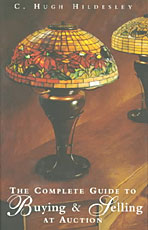|

Auctions,
according to author C. Hugh Hildesley, "are the method of
selling by which property passes from the seller to the buyer at the
highest price offered in a public forum." In his book "The
Complete Guide To Buying & Selling At Auction," Hildesley
explains the ins and outs of auctions, the process of buying and
selling, how auctions houses work, and how to pick the best auction
house.
Auctions
are almost as old as civilization itself, with some the earliest
documented auctions occurring in the slave trade of ancient Babylon.
Although there have been many different kinds of auctions since
then, the type familiar to most people is the fine arts auction.
This is the type of auction used by the author for illustrative
purposes.
In
"Inside the Auction House," Hildesley describes the
personnel working at these houses, the specialists who examine and
appraise the items, how exhibitions are planned and executed, and
how sales are made.

Generally
the most intriguing aspect of an auction is the buying and selling
of items. "How to Sell at Auction," guides the reader
through the process of choosing the right auction house, how to
approach the house for sales information, and the terms and
conditions for the purchase and payment of an item.
At
the opposite end of the spectrum is "How to Buy at
Auction"; this is where much of the excitement is generated.
Hildesley identifies the different kinds of buyers (private,
institutional, dealers, etc.), how to read and understand the house
catalogue, and the different registration and bidding procedures.
[to top of second column in
this review]
|

"The
Auction Adventure: What’s Going on Here?" includes an
in-depth look at the different people who work at the auction and
their responsibilities. The physical logistics of an auction is
discussed, while the glossary of auctioneer’s terms is among the
most important information in the book. Without an understanding of
the meaning of these terms, attending and participating in an
auction can be a frustrating experience.
For
those seeking additional information on auctions, "The Auction
House: A Full Service Resource to the Art World" discusses
appraising, insurance and fair market value. This chapter also
describes the different services and programs available through an
auction house. Programs can include educational seminars and charity
sales/benefits, while services in restoration, estates, real estate
and finances may be available. Hildesley’s attitude toward
auctions is best summarized when he writes, "It is the passion
for collecting that has, over the years, brought together major
groups of works of art…it is my profound belief that the great
collectors of any age are driven by a passion to acquire that is
based on a conscious ability to discern quality in the realm of
art."
"The
Complete Guide To Buying & Selling At Auction" removes the
mystery and uncertainty surrounding the auction process. It is an
outstanding source of information and should be among the first
works consulted on the subject. In addition to Hildesley’s clear
explanations of the way auctions work, he has also included a
variety of sample documents and catalogue pages. These include a
sample auction catalogue entry, absentee bid form, appraisal
agreement form, and a list defining the terms and phrases used by
prospective buyers and sellers. This book is highly recommended to
anyone who is interested in acquainting themselves with the world of
auctions and auction houses.
For
more information, visit the library at 725 Pekin St. or call (217)
732-8878.
[Richard Sumrall, Lincoln
Public Library District]
|

